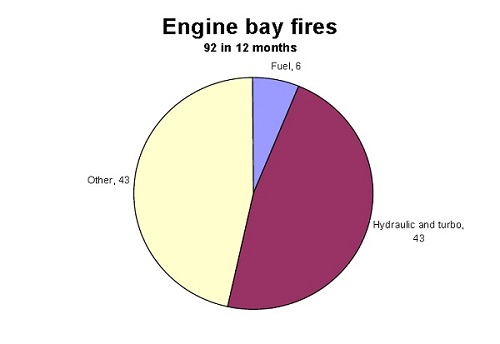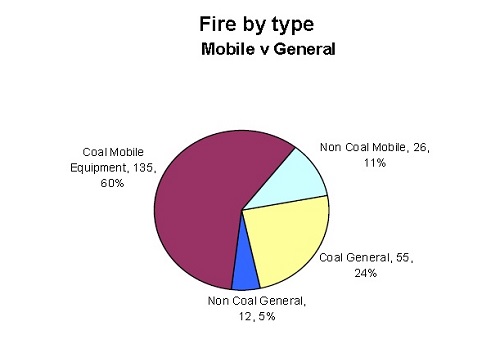
Mines safety bulletin no. 86 | 30 September 2008 | Version 1
Fires on mine sites
Background
In June 2008, Safety Alert 197 – Diesel engine – Turbocharger fire was issued in response to the increasing number of fires occurring on mine sites. An initial analysis of reported data showed that fires associated with turbochargers were increasing.
As required by legislation, all mines report high potential incidents to the Department of Mines and Energy. From this reported data, a more detailed study of the occurrence of fires in general has been made, the results of which can now be reported.
In total, there were 228 fires in the 12 month period and each had the potential to harm a person. It is therefore critical that the industry takes steps to reduce the number of fires.
The 4 diagrams below report on the period 1 August 2007 to 31 July 2008.
Results
The first diagram shows where fires were occurring in the Department of Mines and Energy regions—Central Region has been broken up into Rockhampton and Mackay, for obvious reasons. It reports on the:
- number of fires on a vehicle or plant
- number of fires that have endangered the safety or health of a person.
The second diagram below shows the same data split 4 ways into:
- coal mining
- non-coal mining
- those specifically on mobile equipment
- general fires, such as
- material handling, specifically belt conveying
- process and coal preparation plants
- cutting and welding incidents
- any reported fire that did not have a stated mobile equipment involvement.
It is clear that coal mines and mobile equipment account for the vast majority of the fires.
A closer examination of the 161 fires that occurred on mobile equipment shows 92 in the engine bay and 69 elsewhere on the equipment.
The third diagram shows the 69 fires which occurred on mobile equipment but not in the engine bay.
The 28 fires reported as having an electrical source included:
- alternator
- starter motor jammed
- overheated cables
- cables shorted due to burnt insulation (engine hot surface).
Twenty-four fires were from a myriad of causes including:
- steering hose blown
- frictional heat from rubbing against moving part
- fires that did not have a cause stated in the report.
The remaining 17 fires were wheel bearings (mainly on road style haulage trucks and trailers) and brakes (heavy transport float).
Improved inspection and maintenance of the mobile equipment would have detected and removed many of these 'elsewhere on the vehicle' sources and prevented the fire from occurring.
In the fourth diagram below, of the 92 fires in the engine bay, the turbocharger was mentioned in 43 cases.
Consistently reported were 'hose failed and sprayed oil onto the turbo charger' or 'the turbo charger failed causing a fire from the resultant cooling oil leak'.
It would be expected that diesel fuel fires would predominate in an analysis of engine bay fires but diesel fuel from cracked or leaking fuel lines was remarkably low in occurrence. This is testament to the modification work done by equipment manufacturers in answer to a similar rise in engine bay fires almost a decade ago.
The 'other' category, also with 43 fires, indicates poor maintenance practices and includes such things as:
- rag and flammable material left in the engine well
- rag fell onto hot engine
- fuel or oil spilled by fitter onto hot engine
- loose oil and fuel filter housing.
All of these could be controlled with increased vigilance and care of maintenance personnel.
In the engine bay of a diesel driven machine, there exist a number of inherent hazards:
- hot surfaces
- pressurised oil and fuel lines that will perish over time due to the heat
- vibrations that cause components to become loose or leak.
Quality maintenance practices are required to control these hazards and prevent the all-too-common occurrence of fire. Very few reported fires in the engine bay have resulted in any change to fire control, the fires will continue as long as there are no positive controls put in place.
Routine replacement of hoses before imminent failure, routine change out of critical components, such as the turbocharger, are just 2 of the preventative measures that are well-known, easily achieved but rarely feature in mines maintenance practices. Spending less on maintenance is not a viable costcutting strategy. The pain of poor maintenance will last long after the pleasure of cost cutting.
Contact: John Smith, Senior Inspector of Mines (Mechanical) , +61 7 4967 0861
Issued by Queensland Department of Mines and Energy
Find more safety notices
Search the hazards database



